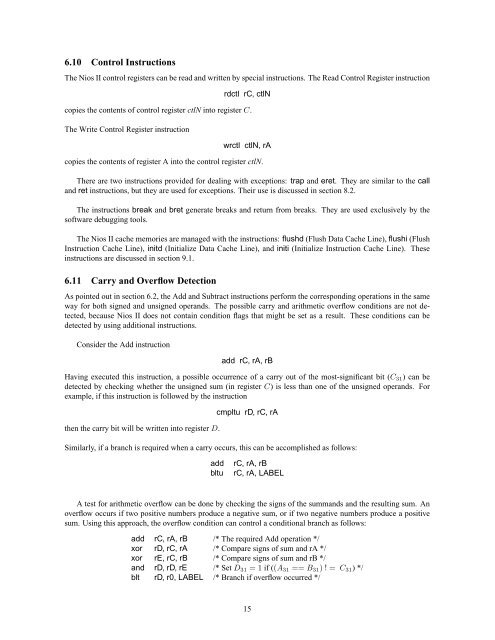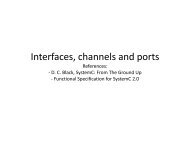Introduction to the Altera Nios II Soft Processor - FTP - Altera
Introduction to the Altera Nios II Soft Processor - FTP - Altera
Introduction to the Altera Nios II Soft Processor - FTP - Altera
You also want an ePaper? Increase the reach of your titles
YUMPU automatically turns print PDFs into web optimized ePapers that Google loves.
6.10 Control Instructions<br />
The <strong>Nios</strong> <strong>II</strong> control registers can be read and written by special instructions. The Read Control Register instruction<br />
rdctl rC, ctlN<br />
copies <strong>the</strong> contents of control register ctlN in<strong>to</strong> register C.<br />
The Write Control Register instruction<br />
wrctl ctlN, rA<br />
copies <strong>the</strong> contents of register A in<strong>to</strong> <strong>the</strong> control register ctlN.<br />
There are two instructions provided for dealing with exceptions: trap and eret. They are similar <strong>to</strong> <strong>the</strong> call<br />
and ret instructions, but <strong>the</strong>y are used for exceptions. Their use is discussed in section 8.2.<br />
The instructions break and bret generate breaks and return from breaks. They are used exclusively by <strong>the</strong><br />
software debugging <strong>to</strong>ols.<br />
The <strong>Nios</strong> <strong>II</strong> cache memories are managed with <strong>the</strong> instructions: flushd (Flush Data Cache Line), flushi (Flush<br />
Instruction Cache Line), initd (Initialize Data Cache Line), and initi (Initialize Instruction Cache Line). These<br />
instructions are discussed in section 9.1.<br />
6.11 Carry and Overflow Detection<br />
As pointed out in section 6.2, <strong>the</strong> Add and Subtract instructions perform <strong>the</strong> corresponding operations in <strong>the</strong> same<br />
way for both signed and unsigned operands. The possible carry and arithmetic overflow conditions are not detected,<br />
because <strong>Nios</strong> <strong>II</strong> does not contain condition flags that might be set as a result. These conditions can be<br />
detected by using additional instructions.<br />
Consider <strong>the</strong> Add instruction<br />
add rC, rA, rB<br />
Having executed this instruction, a possible occurrence of a carry out of <strong>the</strong> most-significant bit (C 31 ) can be<br />
detected by checking whe<strong>the</strong>r <strong>the</strong> unsigned sum (in register C) is less than one of <strong>the</strong> unsigned operands. For<br />
example, if this instruction is followed by <strong>the</strong> instruction<br />
<strong>the</strong>n <strong>the</strong> carry bit will be written in<strong>to</strong> register D.<br />
cmpltu rD, rC, rA<br />
Similarly, if a branch is required when a carry occurs, this can be accomplished as follows:<br />
add<br />
bltu<br />
rC, rA, rB<br />
rC, rA, LABEL<br />
A test for arithmetic overflow can be done by checking <strong>the</strong> signs of <strong>the</strong> summands and <strong>the</strong> resulting sum. An<br />
overflow occurs if two positive numbers produce a negative sum, or if two negative numbers produce a positive<br />
sum. Using this approach, <strong>the</strong> overflow condition can control a conditional branch as follows:<br />
add rC, rA, rB /* The required Add operation */<br />
xor rD, rC, rA /* Compare signs of sum and rA */<br />
xor rE, rC, rB /* Compare signs of sum and rB */<br />
and rD, rD, rE /* Set D 31 = 1 if ((A 31 == B 31 ) ! = C 31 ) */<br />
blt rD, r0, LABEL /* Branch if overflow occurred */<br />
15

















